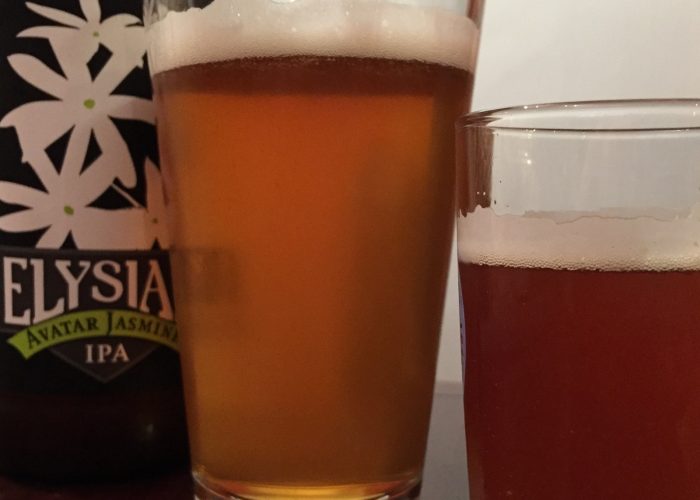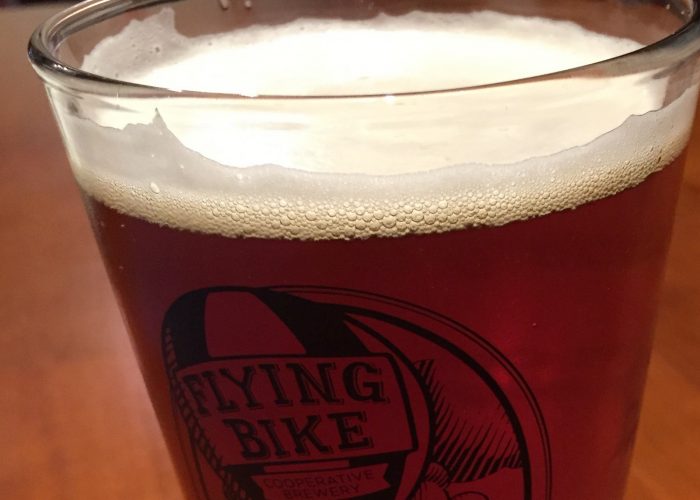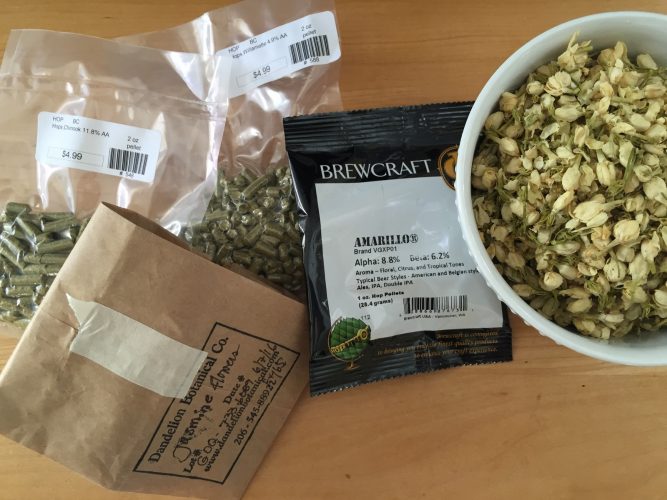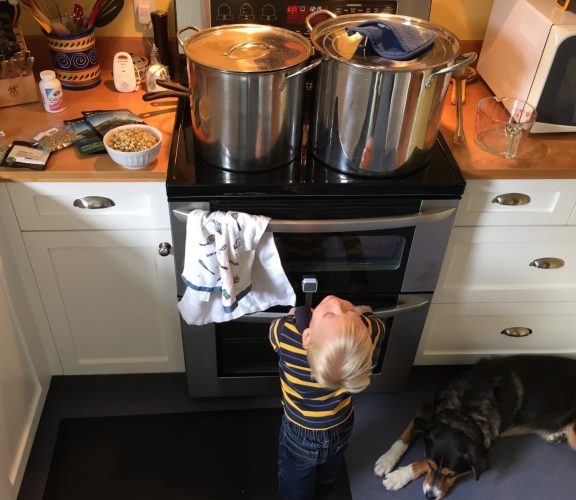Naptime Jasmine IPA

This brew is based on a clone of Elysian’s Avatar Jasmine IPA that I brewed on the stovetop during my toddler’s nap. Naptime Jasmine IPA. Naps aren’t that long, though, so I had to cheat and start before his nap and was still wrapping up when he woke.
I was running out of time to brew a beer this summer that would be ready in time to take to our friend Dean’s Brewfest in mid-September. I didn’t have the regular propane brew gear available this weekend, so I brewed on the stovetop for the first time since trying small batch brewing with the Apple Brown Betty Fall Ale.
Results
Overview
- Starting gravity (actual):
- 1.070 (at 4.5 gallons)
- Starting gravity (calculated):
- 1.063 (topped to 5 gallons)
- Starting gravity (expected):
- 1.062
- Final gravity (actual):
- 1.015
- ABV
- 7.22%
It’s bitter with a not-too-strong aroma. Very dirty with sediment on the first few pours from the keg, but seems to get better over time. It’s actually quite bitter. Unfortunately I don’t detect a lot of jasmine—just a hint. But it’s a good IPA. Real clean flavor, which I don’t always get for my beers. Despite not picking up a lot of jasmine flavor, I’m pretty happy with this beer.
Jer claims that it has tons of flowery jasmine flavor. Kolbe says it’s good, but also doesn’t taste the flowery flavors that Jer noticed. Dean likes it and thinks it smells and tastes like weed (it kind of does) and also noted that it was clear and didn’t have the off-flavors that you often get in homebrew.

Recipe
This was based on a clone recipe for Elysian’s Avatar Jasmine IPA that came straight from Dick Cantwell. The base hops for this recipe are listed as 7.5 AAU of Chinook hops.
I also stumbled across this thread that discusses Naked City Brewing’s version called Femme Fatale Jasmine IPA, which is based on the same clone recipe but changed the base hops from Chinook to Northern Brewer and dropped to 2 oz because 7.5 AAU calculated out to around 4 oz of hops, which pushes the total IBUs to over 100—too high for this beer.
I stuck with Chinook hops, but went with the suggested 2 oz. That was probably wrong. By my own AAU calculation with 11.8% AA Chinook hops, I should have had less than an ounce of Chinook hops:
7.5 AAU = X oz * 11
X oz = 7.5 / 11 = 0.68 oz
That would explain the bitterness.

Here is the recipe that I used, which differs slightly from both of those links. I stuck with Elysian’s Chinook hops, but did only use 2 oz. I think this was a good decision.
Malt
- 0.5 lbs Munich Malt
- 0.25 lbs Dextrin Malt (Carapils 1.5L)
- 0.25 lbs 40L Crystal Malt
- 8.5 lbs Light (Pale Ale) Liquid Malt Extract
Hops
- 2 oz Chinook pellet hops
- 90 minutes
- 1.5 oz Willamette pellet hops
- 2 minutes
- 0.5 oz Amarillo pellet hops
- 0 minutes (steep)
- 0.5 oz Amarillo pellet hops
- Day 10 (dry hop)
Other
- 1.5 oz dried Jasmine flowers
- 10 minutes
- 0.5 oz dried Jasmine flowers
- 0 minutes (steep)
Yeast
-
2 packs Wyeast 1056 American Ale
- For the recipe’s “Light Dextrin Malt (Carahell)” I used what was marked as Dextrin Malt and was actually Carapils 1.5L. Carapils is apparently not the same, since Carahell is just a trade name for Weyermann’s Caramel 10L. Confusing and lame, but it’s not going to make a big difference at such small amounts.
- I’m using 40L Crystal Malt instead of 45L Crystal Malt. Again, it’s not going to make a difference at these small amounts.
- As mentioned above, I went with 2 oz of Chinook buttering hops based on the Naked City thread, but that was probably way higher than it should have been.
- There weren’t any Glacier hops available so I went with Willamette, which I’m pretty happy with and think will turn out well.
- I might be a little under 2oz of dried jasmine flowers, but I cleaned out the store. Big thanks to Dandelion Botanical Company that I even found that much! And for the super-reasonable price of roughly $3. Also, thanks to the guys at Cellar Homebrew for pointing me in the right direction.
Brewing Notes
Timeline
- Brewed
- August 6, 2016 by myself
- Dry Hopped
- August 16, 2016
- Kegged
- August 21, 2016
- Tasted
- August 27, 2016

Stovetop Brewing:
- To get the water boiling quickly I used two pots, each with 3 gallons. I considered doing the entire brew as two half batches, but realized that would just be a huge pain in the ass. The water boiled quickly enough that I had faith that our electric stovetop could handle the job, but still think that splitting the water boil probably helped get going more quickly.
- Note to self: don’t worry too much about the keeping the lid on when doing the initial wort boil (after adding the LME). I was afraid of having a boil over in the kitchen so kept removing the lid and checking the temperature, but never even came close. The loss of heat when taking off the lid probably cost me an extra 20+ minutes in time. I’m using a big brew pot so there wasn’t much to worry about.
- That said, I did almost have a boil over toward the end of the 90 minute boil so don’t get too comfortable. That would have been a huge disaster.
- After transferring to the carboy I added another extra half gallon of water to bring the volume up to 5 gallons. The hydrometer reading of 1.070 is at 4.5 gallons, so the calculated starting gravity is 1.063. My only 6 gallon carboy is still holding the remaining Solera beer, so I had to use the 5 gallon carboy. I ended up losing about a half gallon to blow off, so probably should have just left it at 4.5 gallons and had a higher gravity.
Potential Problems:
- While mashing the crushed grains at somewhere in the range of 153–154°F (as the recipe says) up to the more standard limit of 170° F, at the end of my ~30 minute steep I noticed that the temperature had crept up to 175° or so. This could lead to excessive tannins in the beer. Hopefully it was not long enough to cause a problem.
- Late in the wort boil, at around the 10 and 2 minute marks (when adding the jasmine and hops), I noticed that I no longer had a rolling boil. Maybe I didn’t get enough good stuff extracted out of the late-add ingredients (flavoring and aroma)?
- I wasn’t sure if I should use two packages of yeast or not. The gravity isn’t terribly high, but I thought that the extra packet might help avoid diacetyl problems.
But then, this:Yeast Pitch Rate
Your pitch rate is one of the most critical factors when brewing an IPA or Double IPA. Too much yeast and you could end up with less bitterness due to the fact that the yeast takes up bitterness from the beer.
— Vinnie Cilurzo, 10 Factors to Making Better Hoppy Beers
So maybe I should have stuck with just one package.
Post-Brew:
- I heavily debated whether or not to add the extra 0.5 oz of Amarillo pellets to dry hop. It is a small enough amount that it shouldn’t make a huge difference, but I don’t want to completely kill off any of the subtle Jasmine aroma. I decided to dry hop after sampling 8 days into fermentation because the aroma was nearly nonexistent (but it tasted good!).
- I also considered using gelatin to fine the beer (make it more clear). A bonus is that it might allow any dry hops to have more contact with the beer and thus be more effective (also from Vinnie Cilurzo). It sounds pretty easy but I decided against it because I didn’t want to add more complexity to this first-time Jasmine recipe.